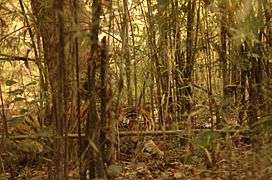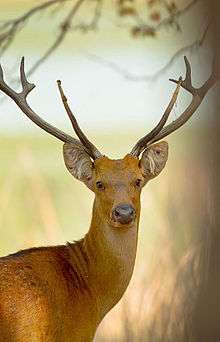Kanha Tiger Reserve
| Kanha Tiger Reserve | |
|---|---|
|
IUCN category II (national park) | |
|
Tiger in Kanha | |
 | |
| Location | Madhya Pradesh, India |
| Nearest city | Mandla |
| Coordinates | 22°20′0″N 80°38′0″E / 22.33333°N 80.63333°ECoordinates: 22°20′0″N 80°38′0″E / 22.33333°N 80.63333°E |
| Area | 940 square kilometres (360 sq mi) |
| Established | 1955 |
| Visitors | 1,000 (in 1989) |
| Governing body | Madhya Pradesh Forest Department |
Kanha Tiger Reserve, also called Kanha National Park, is one of the tiger reserves of India and the largest national park of Madhya Pradesh, state in the heart of India. The present-day Kanha area was divided into two sanctuaries, Hallon and Banjar, of 250 and 300 km2 respectively. Kanha National Park was created on 1 June 1955 and in 1973 was made the Kanha Tiger Reserve. Today it stretches over an area of 940 km2 in the two districts Mandla and Balaghat. Together with a surrounding buffer zone of 1,067 km2 and the neighboring 110 km2 Phen Sanctuary it forms the Kanha Tiger Reserve.[1][2] This makes it the largest National Park in Central India. Kanha Tiger Reserve was ranked in the top 10 Famous Places for Tourists.[3]
The park has a significant population of royal Bengal tiger, Indian leopards, the sloth bear, barasingha and Indian wild dog. The lush sal and bamboo forests, grassy meadows and ravines of Kanha provided inspiration to Rudyard Kipling for his famous novel Jungle Book.
Flora
Kanha Tiger Reserve is home to over 1000 species of flowering plants.[4] The lowland forest is a mixture of sal (Shorea robusta) and other mixed forest trees, interspersed with meadows. The highland forests are tropical moist dry deciduous type and of a completely different nature with bamboo (Dendrocalamus strictus) on slopes. A very good looking Indian ghost tree (Davidia involucrata) can also be seen in the dense forest.
Kanha Tiger Reserve abounds in meadows or maidans which are basically open grasslands that have sprung up in fields of abandoned villages, evacuated to make way for the animals. Kanha meadow is one such example. There are many species of grass recorded at Kanha some of which are important for the survival of barasingha (Cervus duvauceli branderi). Dense forested zones with good crown cover has abundant species of climbers, shrubs and herbs flourishing in the understory. Aquatic plants in numerous tal (lakes) are life line for migratory and wetland species of birds.
 Meadows at Kanha
Meadows at Kanha Open forest at Kanha
Open forest at Kanha Tiger at Kanha hiding in bamboo
Tiger at Kanha hiding in bamboo Axis in Kanha
Axis in Kanha
Fauna
Kanha Tiger Reserve has species of tigers, leopards, wild dogs, wild cats, foxes and jackals. Among the deer species, swamp deer (Cervus duavcelli branderi) or hard ground barasingha is pride of the place as it is the only subspecies of swamp deer in India. The animal is adapted to hard ground unlike swamp deer of the north which live in marshy swamps. The reserve has been instrumental in rescuing the swamp deer from extinction. Indian gaur (Bos guarus), belonging to the ox genus, is found in Kanha but seen mostly as winter ends. In summer gaur inhabit meadows and water holes in the park.
Other commonly seen animals in the park include the spotted deer, sambar, barking deer and the four-horned deer. The latter can be seen at Bamni Dadar climb. Recently, mouse deer have also been discovered in the tiger reserve.
Black buck have inexplicably become very rare.[5] They vanished completely, but have been reintroduced recently inside a fenced area in the park. Nilgai can still be seen near the Sarahi Gate, while the Indian wolf once commonly seen at Mocha is a rare sight now. Hyena and sloth bear are seen occasionally. Langurs and wild boars are common, but the pugnacious rhesus macaque is seen less often.
Nocturnal animals like fox, hyena, jungle cat, civets, porcupine, ratel or honey badger and hares can be seen outside the park confines. Reptiles like pythons, cobras, krait, rat snakes, vipers, keelbacks and grass snakes are nocturnal animals, and are therefore rarely seen. There are many species of turtles as well as amphibians found in or near the water bodies.
Kanha and Satpura National Park being a part of Gondwana, now famous as a tiger reserve, was once ruled by wild Indian elephants.[6]
 Tigers killing a wild boar
Tigers killing a wild boar- Kanha is most famous for its tigers
 The gaur is the largest wild animal in the park
The gaur is the largest wild animal in the park Two dholes at Kanha
Two dholes at Kanha Kanha is the last refuge of the rare hard ground barasingha
Kanha is the last refuge of the rare hard ground barasingha A male hard ground barasingha
A male hard ground barasingha
Reintroduction of barasingha
An exciting conservation effort in this national park is the reintroduction of barasingha. The gaur will be relocated to Bandhavgarh and some barasingha will be relocated to Satpura Tiger Reserve The objective of this project is to introduce about 500 barasingha in this national park to eight or nine different locations. There is also a project to capture about twenty tigers and relocate them to Satpura Tiger Reserve.[7]
Tiger conservation and the Baiga tribe
Members of the Baiga tribe, a semi-nomadic tribe of central India that is reliant on the forest, lived in 28 villages that had been within the Kanha National Park until 1968, when they were relocated. The relocation was part of an effort to maintain a critical tiger habitat.[8] The land to which they were relocated is barren and they now suffer from alcoholism and malnourishment, and beg to support themselves.[8] The last of the villages to be relocated for the tiger habitat is in the core zone of the Kanha Tiger Reserve.[8] The area is the ancestral home of the Gond and Baiga tribes. In January 2010, Baiga tribe were illegally evicted from the park without proper compensation from the government, according to Survival International.[9]
In its efforts to maintain and restore tiger habitats, WWF-India has worked to create corridors that support the tigers and their prey, thereby stabilizing the tiger population. This includes efforts to prevent loss of life or property of humans, reduce human dependency on the forest, and reduce retaliatory killings of tigers when people have experienced losses.[10]
General information
Kanha Tiger Reserve is:
- Area: (core) 940 km2
- Terrain: sal and bamboo forests, plateaus, meadows and meandering streams
- Best season: February to June
- Morning visiting hours: 6:30 am to 11:00 am
- Evening visiting hours: 3:00 pm to 6:00 pm
- Closed: 1 July to 15 October
Transportation and access
The Jabalpur Airport (175 km distance / 04:30hrs) has direct flights to and from Delhi and Mumbai, with AirIndia and SpiceJet operating daily flights. Nagpur (260 km) and Raipur(219 km) have other airports.
Jabalpur is major railway stations with train connectivity across India. From Jabalpur, the best way to travel is via Mandla, which has a tourist taxi service to the park, and Nainpur - perhaps with an overnight stop. Mandla, Nainpur and Seoni all have sports clubs, Internet cafes, guides, Christian churches and some beautiful temples.
There are three gates for entrance into the park. The Kisli gate is best accessed from Jabalpur and stops at the village Khatia, inside the buffer area. The second gate is at Mukki and the third, most recently opened, gate is at Serai.
Ecosystem Valuation
An economic assessment study of Kanha Tiger Reserve estimated that the tiger reserve provides flow benefits worth 16.5 billion rupees (0.80 lakh / hectare) annually. Important ecosystem services from the tiger reserve include gene-pool protection (12.41 billion year), provisioning of water to downstream regions (558 million) and provisioning of fodder in buffer areas (546 million). Other services included recreation value (384 million), provision of habitat and refugia for wildlife (319 million) and sequestration of carbon (219 million).[11]
See also
References
- ↑ "Kanha Tiger Reserve". Madhya Pradesh Forest Department. Retrieved 14 April 2010.
- ↑ "Kahna Tiger Reserve: History and origin (3rd slide)". Kahna Tiger Reserve. Retrieved 21 March 2015.
- ↑ Williams, Sarah. "Top 10 Must Visit Tourist Places in India". Touropia. Retrieved 10 January 2015.
- ↑ "Kanha National Park". Reservation Portal Madhya Pradesh Forest Department. MPOnline Ltd. , JV between MPSEDC of Govt. of Madhya Pradesh & TATA Consultancy Services. Retrieved 14 April 2010.
- ↑ A. P. Dwivendi: Protected Areas of Madhya Pradesh, Government printing Press, Bhopal 2003
- ↑ https://web.archive.org/web/20130811081304/http://www.banglalive.com/News/SpecialNewsDetail/5966. Archived from the original on August 11, 2013. Retrieved August 22, 2013. Missing or empty
|title=(help) - ↑ sala Reintroduction of Barasingha: Kanha National Park – Satpura Tiger Reserve
- 1 2 3 "Out of the Jungle: The Baigas - Sayantan Bera". Galli Magazine. Retrieved 21 March 2015.
- ↑ Survival International. "Tribespeople illegally evicted from 'Jungle Book' tiger reserve". survivalinternational.org. Retrieved 21 March 2015.
- ↑ "WWF India - WWF-India's work for tiger". wwfindia.org. Retrieved 21 March 2015.
- ↑ (PDF) http://www.iifm.ac.in/sites/default/files/Newspdf/IIFM-NTCA-REPORT.compressed-min.pdf. Retrieved 14 August 2016. Missing or empty
|title=(help)
Sources
- K.K.Gurung, Gopal awasthi & Raj Singh: Field Guide to the Mammals of the Indian Subcontinent, Academic Press, San Diego, ISBN 0-12-309350-3
External links
| Wikimedia Commons has media related to Kanha National Park. |
- Official Site
-
 Kanha Tiger Reserve travel guide from Wikivoyage
Kanha Tiger Reserve travel guide from Wikivoyage - Safari Booking
